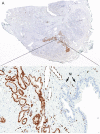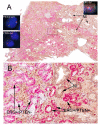Assessing the order of critical alterations in prostate cancer development and progression by IHC: further evidence that PTEN loss occurs subsequent to ERG gene fusion
- PMID: 23545904
- PMCID: PMC3774596
- DOI: 10.1038/pcan.2013.8
Assessing the order of critical alterations in prostate cancer development and progression by IHC: further evidence that PTEN loss occurs subsequent to ERG gene fusion
Abstract
Background: ERG rearrangements and PTEN (phosphatase and tensin homolog deleted on chromosome 10) loss are two of the most common genetic alterations in prostate cancer. However, there is still significant controversy regarding the order of events of these two changes during the carcinogenic process. We used immunohistochemistry (IHC) to determine ERG and PTEN status, and calculated the fraction of cases with homogeneous/heterogeneous ERG and PTEN staining in a given tumor.
Methods: Using a single standard tissue section from the index tumor from radical prostatectomies (N=77), enriched for relatively high grade and stage tumors, we examined ERG and PTEN status by IHC. We determined whether ERG or PTEN staining was homogeneous (all tumor cells staining positive) or heterogeneous (focal tumor cell staining) in a given tumor focus.
Results: Fifty-seven percent (N=44/77) of tumor foci showed ERG positivity, with 93% of these (N=41/44) cases showing homogeneous ERG staining in which all tumor cells stained positively. Fifty-three percent (N=41/77) of tumor foci showed PTEN loss, and of these 66% (N=27/41) showed heterogeneous PTEN loss. In ERG homogeneously positive cases, any PTEN loss occurred in 56% (N=23/41) of cases, and of these 65% (N=15/23) showed heterogeneous loss. In ERG-negative tumors, 51.5% (N=17/33) showed PTEN loss, and of these 64.7% (N=11/17) showed heterogeneous PTEN loss. In a subset of cases, genomic deletions of PTEN were verified by fluorescence in situ hybridization in regions with PTEN protein loss as compared with regions with intact PTEN protein, which did not show PTEN genomic loss.
Conclusions: These results support the concept that PTEN loss tends to occur as a subclonal event within a given established prostatic carcinoma clone after ERG gene fusion. The combination of ERG and PTEN IHC staining can be used as a simple test to ascertain PTEN and ERG gene rearrangement status within a given prostate cancer in either a research or clinical setting.
Figures



Similar articles
-
Heterogeneity and chronology of PTEN deletion and ERG fusion in prostate cancer.Mod Pathol. 2014 Dec;27(12):1612-20. doi: 10.1038/modpathol.2014.70. Epub 2014 Apr 25. Mod Pathol. 2014. PMID: 24762546
-
The prognostic value of SUMO1/Sentrin specific peptidase 1 (SENP1) in prostate cancer is limited to ERG-fusion positive tumors lacking PTEN deletion.BMC Cancer. 2015 Jul 23;15:538. doi: 10.1186/s12885-015-1555-8. BMC Cancer. 2015. PMID: 26202067 Free PMC article.
-
Genomic deletion of PTEN is associated with tumor progression and early PSA recurrence in ERG fusion-positive and fusion-negative prostate cancer.Am J Pathol. 2012 Aug;181(2):401-12. doi: 10.1016/j.ajpath.2012.04.026. Epub 2012 Jun 13. Am J Pathol. 2012. PMID: 22705054
-
The prognostic and predictive value of TMPRSS2-ERG gene fusion and ERG protein expression in prostate cancer biopsies.Dan Med J. 2016 Dec;63(12):B5319. Dan Med J. 2016. PMID: 27910803 Review.
-
Examining the Association between ERG/PTEN Expression and Biochemical Recurrence in Prostate Cancer: A Comprehensive Meta-Analysis.Arch Esp Urol. 2025 Jan;78(1):25-36. doi: 10.56434/j.arch.esp.urol.20257801.4. Arch Esp Urol. 2025. PMID: 39943631
Cited by
-
Precise Immunodetection of PTEN Protein in Human Neoplasia.Cold Spring Harb Perspect Med. 2019 Dec 2;9(12):a036293. doi: 10.1101/cshperspect.a036293. Cold Spring Harb Perspect Med. 2019. PMID: 31501265 Free PMC article. Review.
-
Predicting Prostate Cancer Molecular Subtype With Deep Learning on Histopathologic Images.Mod Pathol. 2023 Oct;36(10):100247. doi: 10.1016/j.modpat.2023.100247. Epub 2023 Jun 10. Mod Pathol. 2023. PMID: 37307876 Free PMC article.
-
The Emerging Predictive and Prognostic Role of Aggressive-Variant-Associated Tumor Suppressor Genes Across Prostate Cancer Stages.Int J Mol Sci. 2025 Jan 1;26(1):318. doi: 10.3390/ijms26010318. Int J Mol Sci. 2025. PMID: 39796175 Free PMC article. Review.
-
PTEN loss is associated with upgrading of prostate cancer from biopsy to radical prostatectomy.Mod Pathol. 2015 Jan;28(1):128-137. doi: 10.1038/modpathol.2014.85. Epub 2014 Jul 4. Mod Pathol. 2015. PMID: 24993522 Free PMC article.
-
Correlations of PTEN and ERG Immunoexpression in Prostate Carcinoma and Lesions Related to Its Natural History: Clinical Perspectives.Curr Issues Mol Biol. 2023 Mar 25;45(4):2767-2780. doi: 10.3390/cimb45040181. Curr Issues Mol Biol. 2023. PMID: 37185705 Free PMC article.
References
-
- Hanahan D, Weinberg RA. Hallmarks of cancer: the next generation. Cell. 2011;144(5):646–674. - PubMed
-
- Tomlins SA, Rhodes DR, Perner S, Dhanasekaran SM, Mehra R, Sun XW, et al. Recurrent fusion of TMPRSS2 and ETS transcription factor genes in prostate cancer. Science. 2005;310(5748):644–648. - PubMed
-
- Di Cristofano A, Pandolfi PP. The multiple roles of PTEN in tumor suppression. Cell. 2000;100(4):387–390. - PubMed
Publication types
MeSH terms
Substances
Grants and funding
LinkOut - more resources
Full Text Sources
Other Literature Sources
Medical
Research Materials

